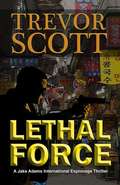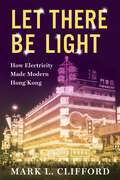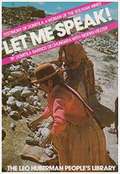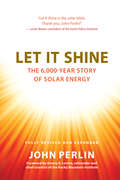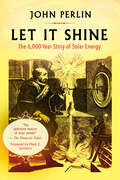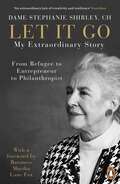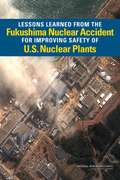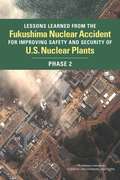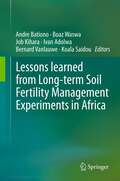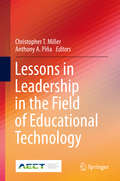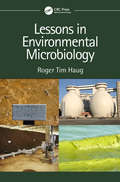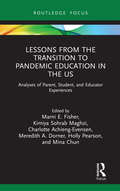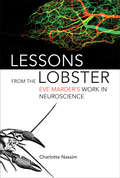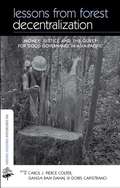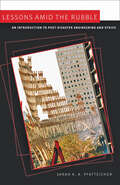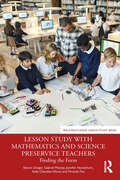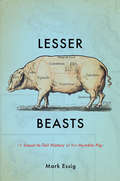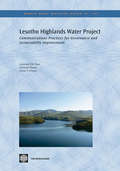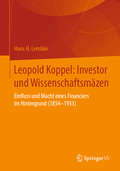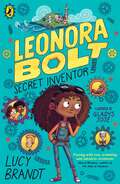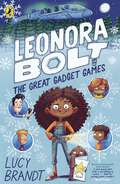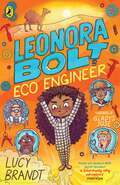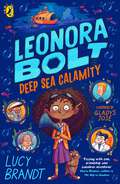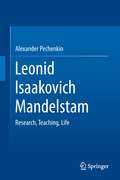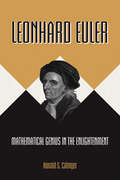- Table View
- List View
Lethal Force
by Trevor ScottJake Adams has seemingly retired and gone fly fishing in Patagonia. But his quiet retreat is interrupted when the Agency sends a man to retrieve him to testify before a congressional committee. His testimony quickly becomes an internet sensation--not a good thing for an autonomous operative. Meanwhile, a college professor is murdered in Oregon and his colleague is nearly killed, sending him running for his life. Jake is drawn back into the shadowy world of espionage to retrieve this professor in Montana and secure his new technology that will make nuclear weapons obsolete. Eventually, Jake finds himself in South Korea in a battle for his life to secure the technology, save a beautiful congresswoman, and stop a cabal of agents from a despotic regime and misguided opportunists. Follow Jake in his most poignant adventure that could either end his life or save his own soul.
Let There Be Light: How Electricity Made Modern Hong Kong (Center on Global Energy Policy Series)
by Mark CliffordThe remarkable success of twentieth-century Hong Kong was driven by electricity. The British colony’s stunning export-driven economic growth, its status as a Cold War capitalist dynamo, its energetic civil society, its alluring urban modernity—all of these are stories of electricity’s transformative power.Let There Be Light is a groundbreaking history of electrification in Hong Kong. Mark L. Clifford traces how a power company and its visionary founder jumpstarted Hong Kong’s postwar economic rise and set in motion far-reaching political and social change against the backdrop of Hong Kong’s shifting relations with the People’s Republic of China and the United Kingdom. Clifford examines avowedly laissez-faire Hong Kong’s attempt to nationalize electricity companies and the longer-term implications of debates over the power supply for citizen activism and the development of civil society, government involvement in tackling housing and other social issues, and state controls on private businesses.Clifford explores the effects of electrification on both grand politics and daily life. In the geopolitical struggle of the Cold War, Hong Kong became an explicitly anti-Communist showcase of production and consumption. Its bright lights and neon signs stood in contrast to the darkness and drabness of neighboring China. Electricity transformed people’s everyday lives, allowing children to study at night, streets to be lit, and shops in a self-consciously commercial mecca to stay open late.Offering new perspectives on twentieth-century Hong Kong, Let There Be Light reveals electricity as a catalyst of modernization.
Let me Speak!: Testimony of Domitila, a Woman of the Bolivian Mines
by Moema Viezzer Domitila Barrios de ChungaraFirst published in English in 1978, this classic book contains the testimony of Domitila Barrios de Chungara, the wife of a Bolivian tin miner. Blending firsthand accounts with astute political analysis, Domitila describes the hardships endured by Bolivia's vast working class and her own efforts at organizing women in the mining community. The result is a gripping narrative of class struggle and repression, an important social document that illuminates the reality of capitalist exploitation in 1970s Bolivia. Domitila Barrios de Chungara was born in 1937 in the Siglo XX mining town in Bolivia. She became politically active in the 1960s and, in 1975, participated in the UN International Women's Year Tribunal in Mexico. In 2005 she was nominated alongside 999 other "Peace Women" for a collective Nobel Peace Prize.
Let It Shine
by John PerlinTells the entire story of humankind's use of solar energy, reaching all the way back 6,000 years to stone age China and then bringing the story all the way up to now. The only book in existence that attempts to tell the entire story of humankind's more than 6,000 year use of solar energy. Most people think of solar power as being a 20th century invention. Few know that the first photovoltaic cells joined the grid on a New York City rooftop in 1881; or that engineers in France used solar power to run steam engines in 1860s; or that in 1901 an ostrich farmer in Southern California used a solar engine with a massive 33-1/2 foot mirrored dish to irrigate 300 acres of trees by pumping 1,400 gallons of water every minute from a reservoir using nothing but the power of the sun. And these are just a few of the incredible stories that will be told in the book. Author John Perlin began telling this story in 1980 with the first edition of their book A Golden Thread, which then went back 2,500 years and covered up through the late 70s. The book sold 55,000 copies and received rave reviews, with the reviewer for The Los Angeles Times calling it a "humbling book" and a "rich mine of information." The New York Times called it "A clear and evocative account of the 2,500-year history of a technology - solar energy - that many people thought was a purely 20th century development" and The Washington Post gave the book an even stronger review calling it a "careful, thoughtful" book that touches on "an awesome range of solar uses and issues." Lester Brown, Founder of the Worldwatch institute has said, "A Golden Thread has become a classic" and a contributor to the popular energy blog "The Oil Drum" wrote that it is "like The Prize but from a solar perspective."
Let It Shine: The 6,000-Year Story of Solar Energy
by John PerlinThe definitive history of solar power and technology Even as concern over climate change and energy security fuel a boom in solar technology, many still think of solar as a twentieth-century wonder. Few realize that the first photovoltaic array appeared on a New York City rooftop in 1884, or that brilliant engineers in France were using solar power in the 1860s to run steam engines, or that in 1901 an ostrich farmer in Southern California used a single solar engine to irrigate three hundred acres of citrus trees. Fewer still know that Leonardo da Vinci planned to make his fortune by building half-mile-long mirrors to heat water, or that the Bronze Age Chinese used hand-size solar-concentrating mirrors to light fires the way we use matches and lighters today. With thirteen new chapters, Let It Shine is a fully revised and expanded edition of A Golden Thread, Perlin’s classic history of solar technology, detailing the past forty years of technological developments driving today’s solar renaissance. This unique and compelling compendium of humankind’s solar ideas tells the fascinating story of how our predecessors throughout time, again and again, have applied the sun to better their lives — and how we can too.
Let It Go: My Extraordinary Story - From Refugee to Entrepreneur to Philanthropist
by Dame Stephanie Shirley CH Richard AskwithA moving memoir from a woman who made a fortune in a man's world and then gave it all away...soon to be turned into a filmIn 1962, Stephanie 'Steve' Shirley created a software company when the concept of software barely existed. Freelance Programmers employed women to work on complex projects such as Concorde's black box recorder from the comfort of their own home. Shirley empowered a generation of women in technology, giving them unheard of freedom to choose their own hours and manage their own workloads. The business thrived and Shirley gradually transferred ownership to her staff, creating 70 millionaires in the process.Let It Go explores Shirley's trail blazing career as an entrepreneur but it also charts her incredible personal story - her dramatic arrival in England as an unaccompanied Kindertransport refugee during World War Two and the tragic loss of her only child who suffered severely from Autism.Today, Dame Stephanie Shirley is one of Britain's leading philanthropists, devoting most of her time, energy and wealth to charities that are close to her heart. In Let It Go, Shirley tells her inspirational story and explains why giving her wealth away - letting it go - has brought her infinitely more happiness and fulfilment than acquiring it in the first place.Co-written with Richard Askwith, the former Executive Editor of The Independent and the award-winning author of seven books in his own name, including biographies of Emil Zátopek and Lata Brandisová.'An extraordinary tale of creativity and resilience' - Guardian'This engrossing story of an extraordinary life is filled with lessons in what it means to be human' - Financial Times
Lessons Learned from the Fukushima Nuclear Accident for Improving Safety of U.S. Nuclear Plants
by Committee on Lessons Learned from the Fukushima Nuclear Accident for Improving Safety Security of U.S. Nuclear PlantsThe March 11, 2011, Great East Japan Earthquake and tsunami sparked a humanitarian disaster in northeastern Japan. They were responsible for more than 15,900 deaths and 2,600 missing persons as well as physical infrastructure damages exceeding $200 billion. The earthquake and tsunami also initiated a severe nuclear accident at the Fukushima Daiichi Nuclear Power Station. Three of the six reactors at the plant sustained severe core damage and released hydrogen and radioactive materials. Explosion of the released hydrogen damaged three reactor buildings and impeded onsite emergency response efforts. The accident prompted widespread evacuations of local populations, large economic losses, and the eventual shutdown of all nuclear power plants in Japan. Lessons Learned from the Fukushima Nuclear Accident for Improving Safety and Security of U. S. Nuclear Plants is a study of the Fukushima Daiichi accident. This report examines the causes of the crisis, the performance of safety systems at the plant, and the responses of its operators following the earthquake and tsunami. The report then considers the lessons that can be learned and their implications for U. S. safety and storage of spent nuclear fuel and high-level waste, commercial nuclear reactor safety and security regulations, and design improvements. Lessons Learned makes recommendations to improve plant systems, resources, and operator training to enable effective ad hoc responses to severe accidents. This report's recommendations to incorporate modern risk concepts into safety regulations and improve the nuclear safety culture will help the industry prepare for events that could challenge the design of plant structures and lead to a loss of critical safety functions. In providing a broad-scope, high-level examination of the accident, Lessons Learned is meant to complement earlier evaluations by industry and regulators. This in-depth review will be an essential resource for the nuclear power industry, policy makers, and anyone interested in the state of U. S. preparedness and response in the face of crisis situations.
Lessons Learned from the Fukushima Nuclear Accident for Improving Safety and Security of U.S. Nuclear Plants: Phase 2
by National Academies of Sciences Engineering MedicineThe U.S. Congress asked the National Academy of Sciences to conduct a technical study on lessons learned from the Fukushima Daiichi nuclear accident for improving safety and security of commercial nuclear power plants in the United States. This study was carried out in two phases: Phase 1, issued in 2014, focused on the causes of the Fukushima Daiichi accident and safety-related lessons learned for improving nuclear plant systems, operations, and regulations exclusive of spent fuel storage. This Phase 2 report focuses on three issues: (1) lessons learned from the accident for nuclear plant security, (2) lessons learned for spent fuel storage, and (3) reevaluation of conclusions from previous Academies studies on spent fuel storage.
Lessons learned from Long-term Soil Fertility Management Experiments in Africa
by Boaz Waswa Koala Saidou Andre Bationo Ivan Adolwa Job Kihara Bernard VanlauweThis book elucidates the importance of long-term experiments in revealing evidence of soil fertility decline in Africa. An evaluation of experiences from on-going long-term experiments is given in broad detail. The first chapter explains the paradigm shift in soil fertility management then provides justification for long-term experiments before illuminating experiences from long-term experiments in East, West and Southern Africa. The second, sixth, eighth and ninth chapters give an in-depth account of crop management practices and soil fertility interventions in long-term trials within specific agro-ecological zones in West Africa. The rest of the chapters (chapter three, four, five and seven) address crop management, tillage practices and, organic and inorganic fertilizer applications in the context of long-term experiments in specific agro-ecological zones in East Africa.
Lessons in Leadership in the Field of Educational Technology
by Anthony A. Piña Christopher T. MillerThe idea for this edited book came about due to the increased discussion and focus on leadership within the educational technology field and particularly in the Association for Educational Communications and Technology organization. There is a diverse amount of individuals in leadership in the field that contributed their lessons learned. This book focuses on sharing the lessons learned by leaders in the field on how they became a leader and what leadership means. The primary contributions address three central questions. What is your story about how you became a leader? What lessons have you learned about being an effective leader? What advice would you give others to become a leader? In addition, this book spotlights the impact that past leaders have had on current leaders and upon the field of educational technology.
Lessons in Environmental Microbiology
by Roger Tim HaugLessons in Environmental Microbiology provides an understanding of the microbial processes used in the environmental engineering and science fields. It examines both basic theory as well as the latest advancements in practical applications, including nutrient removal and recovery, methanogenesis, suspended growth bioreactors, and more. The information is presented in a very user-friendly manner; it is not assumed that readers are already experts in the field. It also offers a brief history of how microbiology relates to sanitary practice, and examines the lessons learned from the great epidemics of the past. Numerous worked example problems are presented in every chapter.
Lessons from the Transition to Pandemic Education in the US: Analyses of Parent, Student, and Educator Experiences (Routledge Research in Education)
by Marni E. Fisher; Kimiya Sohrab Maghzi; Charlotte Achieng-Evensen; Meredith A. Dorner; Holly Pearson; Mina ChunThis volume narrates and shares the often-unheard voices of students, parents, and educators during the COVID-19 pandemic. Through close analysis of their lived experiences, the book identifies key patterns, pitfalls, and lessons learnt from pandemic education. Drawing on contributions from all levels of the US education system, the book situates these myriad voices and perspectives within a prismatic theory framework in order to recognise how these views and experiences interconnect. Detailed narrative and phenomenological analysis also call attention to patterns of inequality, reduced social and emotional well-being, pressures on parents, and the role of communication, flexibility, and teacher-led innovation. Chapters are interchanged with interludes that showcase a lyrical and authentic approach to understanding the multiplicity of experience in the text. Providing a valuable contribution to the contemporary field of pandemic education research, this volume will be of interest to researchers, academics, and educators with an interest in the sociology of education, online teaching and eLearning, and those involved with the digitalization of education at all levels. Those more broadly interested in educational research methods and the effects of home-schooling will also benefit.
Lessons from the Lobster: Eve Marder's Work in Neuroscience (The\mit Press Ser.)
by Charlotte NassimHow forty years of research on thirty neurons in the stomach of a lobster has yielded valuable insights for the study of the human brain.Neuroscientist Eve Marder has spent forty years studying thirty neurons on the stomach of a lobster. Her focus on this tiny network of cells has yielded valuable insights into the much more complex workings of the human brain; she has become a leading voice in neuroscience. In Lessons from the Lobster, Charlotte Nassim describes Marder's work and its significance accessibly and engagingly, tracing the evolution of a supremely gifted scientist's ideas. From the lobster's digestion to human thought is very big leap indeed. Our brains selectively recruit networks from about ninety billion available neurons; the connections are extremely complex. Nevertheless, as Nassim explains, Marder's study of a microscopic knot of stomatogastric neurons in lobsters and crabs, a small network with a countable number of neurons, has laid vital foundations for current brain research projects. Marder's approach is as intuitive as it is analytic, but always firmly anchored to data. Every scrap of information is a pointer for Marder; her discoveries depend on her own creative thinking as much as her laboratory's findings. Nassim describes Marder's important findings on neuromodulation, the secrets of neuronal networks, and homeostasis. Her recognition of the importance of animal-to-animal variability has influenced research methods everywhere.Marder has run her laboratory at Brandeis University since 1978. She was President of the Society for Neuroscience in 2008 and she is the recipient of numerous awards, including the 2016 Kavli Award in Neuroscience and the 2013 Gruber Prize in Neuroscience. Research that reaches the headlines often depends on technical fireworks, and especially on spectacular images. Marder's work seldom fits that pattern, but this book demonstrates that a brilliant scientist working carefully and thoughtfully can produce groundbreaking results.
Lessons from Forest Decentralization: Money, Justice and the Quest for Good Governance in Asia-Pacific (The Earthscan Forest Library)
by Doris Capistrano Ganga Ram Dahal Carol J. Pierce ColferThe decentralization of control over the vast forests of the world is moving at a rapid pace, with both positive and negative ramifications for people and forests themselves. The fresh research from a host of Asia-Pacific countries described in this book presents rich and varied experience with decentralization and provides important lessons for other regions. Beginning with historical and geographical overview chapters, the book proceeds to more in-depth coverage of the region's countries. Research findings stress rights, roles and responsibilities on the one hand, and organization, capacity-building, infrastructure and legal aspects on the other. With these overarching themes in mind, the authors take on many controversial topics and address practical challenges related to financing and reinvestment in sustainable forest management under decentralized governance. Particular efforts have been made to examine decentralization scales from the local to the national, and to address gender issues. The result is a unique examination of decentralization issues in forestry with clear lessons for policy, social equity, forest management, research, development and conservation in forested areas across the globe from the tropics to temperate regions. Published with CIFOR
Lessons amid the Rubble: An Introduction to Post-Disaster Engineering and Ethics (Johns Hopkins Introductory Studies in the History of Technology)
by Sarah K. PfatteicherThe aftermath of September 11, 2001, brought the subject of engineering-failure forensics to public attention as had no previous catastrophe. In keeping with the engineering profession's long tradition of building a positive future out of disasters, Lessons amid the Rubble uses the collapse of the World Trade Center towers to explore the nature and future of engineering education in the United States. Sarah K. A. Pfatteicher draws on historical and current practice in engineering design, construction, and curricula to discuss how engineers should conceive, organize, and execute a search for the reasons behind the failure of man-made structures. Her survey traces the analytical journey engineers take after a disaster and discusses the technical, social, and moral implications of their work. After providing an overview of the investigations into the collapse of the Twin Towers, Pfatteicher explores six related events to reveal deceptively simple lessons about the engineering enterprise, each of which embodies an ethical dilemma at the heart of the profession. In tying these themes together, Pfatteicher highlights issues of professionalism and professional identity infused in engineering education and encourages an explicit, direct conversation about their meaning.Sophisticated and engagingly written, this volume combines history, engineering, ethics, and philosophy to provoke a deep discussion about the symbolic meaning of buildings and other structures and the nature of engineering.
Lesson Study with Mathematics and Science Preservice Teachers: Finding the Form (WALS-Routledge Lesson Study Series)
by Sharon Dotger Gabriel Matney Jennifer Heckathorn Kelly Chandler-Olcott Miranda FoxThis insightful volume offers an overview of the fundamentals of lesson student practice in US teacher education as well as examples from math and science teacher educators using lesson study in their local contexts. The number of teacher educators using lesson study with preservice teachers is small but growing. This book is aimed at teacher educators who may want to try lesson study in university contexts without the challenge of translating the practice from the K-12 context on their own. In this volume, lesson study is broadly overviewed, attention is given to its constituent steps, and examples of lesson study in preservice contexts are shared. Given the broad array of teacher education program designs, numerous contingencies guide teacher educators in their implementation of lesson study, given their contextual affordances and limitations. The lesson study descriptions and cases in this book will support teacher educators and scholars across subject specialities and geographic lines, as they seek instructional frameworks to advance their pedagogical goals.
Lesser Beasts: A Snout-to-Tail History of the Humble Pig
by Mark EssigUnlike other barnyard animals, which pull plows, give eggs or milk, or grow wool, a pig produces only one thing: meat. Incredibly efficient at converting almost any organic matter into nourishing, delectable protein, swine are nothing short of a gastronomic godsend--yet their flesh is banned in many cultures, and the animals themselves are maligned as filthy, lazy brutes. As historian Mark Essig reveals in Lesser Beasts, swine have such a bad reputation for precisely the same reasons they are so valuable as a source of food: they are intelligent, self-sufficient, and omnivorous. What’s more, he argues, we ignore our historic partnership with these astonishing animals at our peril. Tracing the interplay of pig biology and human culture from Neolithic villages 10,000 years ago to modern industrial farms, Essig blends culinary and natural history to demonstrate the vast importance of the pig and the tragedy of its modern treatment at the hands of humans. Pork, Essig explains, has long been a staple of the human diet, prized in societies from Ancient Rome to dynastic China to the contemporary American South. Yet pigs’ ability to track down and eat a wide range of substances (some of them distinctly unpalatable to humans) and convert them into edible meat has also led people throughout history to demonize the entire species as craven and unclean. Today’s unconscionable system of factory farming, Essig explains, is only the latest instance of humans taking pigs for granted, and the most recent evidence of how both pigs and people suffer when our symbiotic relationship falls out of balance. An expansive, illuminating history of one of our most vital yet unsung food animals, Lesser Beasts turns a spotlight on the humble creature that, perhaps more than any other, has been a mainstay of civilization since its very beginnings--whether we like it or not.
Lesotho Highlands Water Project: Communication Practices for Governance and Sustainability Improvement
by Leonardo Mazzei Lawrence J. M. Haas Donal O'LearyThis paper considers the multi-faceted lessons of the Lesotho Highlands Water Project and how the project can serve as a model of mutually beneficial development, though demonstrating the benefits of a bilateral governmental cooperative approach in the development of an international river. These benefits include exceeding the impact of individual national approaches and strengthening political cooperation among all participants. This model is particularly relevant since approximately 40 percent of the world's population lives in transboundary river basins and more than 90 percent of the world's population lives within countries that share these basins.
Leopold Koppel: Einfluss und Macht eines Financiers im Hintergrund (1854–1933)
by Hans H. LembkeLeopold Koppel (1854 –1933) war zu seiner Zeit eine der bedeutendsten Persönlichkeiten des deutschen Wirtschaftslebens, als Investor und Stifter. Sein erster großer Coup gelang ihm in der Gasbeleuchtung, sein zweiter mit elektrischem Licht – und der Marke Osram. Mittels Übernahme chancenreicher Unternehmen besetzte er auch in der Hotellerie und Gastronomie erste Plätze. Neue Dimensionen erschloss er sich als Wissenschaftsmäzen mit Allerhöchster Anerkennung. Als erstrangiger Financier der Kaiser-Wilhelm-Gesellschaft setzte er auf die Physikalische Chemie, die er auch rüstungs-industriell nutzte. In den Weimarer Jahren schwanden Tatkraft und Bedeutung, doch selbst den Rückbau seines Konzerns unternahm er strategisch. Leopold Koppel starb im Spätsommer 1933; die Enteignung blieb ihm erspart. Zwei Enkel wurden im US-Exil zu erfolgreichen Unternehmern, ebenfalls mit Zugang zum politischen Gipfel.Der InhaltBiografie eines Unternehmers im HalbschattenDer Selfmademan aus fast namenloser FamilieDer Wettlauf zwischen Strom- und GaslichtDer Durchbruch der elektrischen LichttechnikDie Investitionschancen in umkämpften ZukunftszweigenDie Hotelbetriebs-Gesellschaft Der Wissenschaftsmäzen in kaiserlicher GunstDie Expansion in die Kriegswirtschaft Der Konzernumbau in den zwanziger Jahren Der Niedergang Die Unternehmensrelikte und Bruchstücke des VermögensDer AutorProf. Dr. Hans H. Lembke lehrte Wirtschaftswissenschaften an der Technischen Hochschule Brandenburg.
Leonora Bolt: Secret Inventor (Leonora Bolt: Secret Inventor #1)
by Lucy Brandt'Fizzing with fun, friendship and fabulous inventions!' - Maria KuzniarWARNING: EPIC INVENTIONS AND SECRET SOCIETIES AHEAD . . .Leonora Bolt spends her days creating incredible inventions in her TOP SECRET laboratory, under the watchful eye of her terrifying uncle.Everything changes one day when a strange boy washes up on an inflatable lobster and reveals that Uncle Luther has been stealing her inventions and selling them on the mainland. Leonora, armed with her most important inventions, must leave Crabby Island for the first time EVER to embark on an unforgettable journey that will test her brainpower to its limits.With the help of an otter with a special skilll, a questionable cook and a singing sea captain, can Leonora dream up an invention that will defeat her evil uncle once and for all?Violet Baudelaire meets Peanut Jones in this epic STEM-themed adventure about believing in your brainpower - and yourself!
Leonora Bolt: The Great Gadget Games (Leonora Bolt: Secret Inventor #4)
by Lucy BrandtThe fourth hilarious book in the brilliant STEM adventure series Leonora Bolt. With glorious illustrations by Gladys Jose throughout.It's Leonora first Christmas, and the brilliant young inventor is feeling festive! She's made presents, Mildred's boiling cabbage for the candy canes (yuck!), and best friend Jack's brought along . . .an invite to the Great Gadget Games?!Her villainous Uncle Luther is behind this new inventing show, and planning on stealing the creations made by the very talented contestants. And in ANOTHER twist, the judges of the competition are two people very dear to Leonora's heart.Leonora HAS to enter - it's her best-ever chance to finally stop Luther's dangerous games! But she can't enter as herself - he'll never allow that - so she'll need a foolproof disguise, and a brilliant idea for a winning invention . . .Violet Baudelaire meets Peanut Jones in this epic STEM-themed adventure about believing in your brainpower - and yourself.
Leonora Bolt: Eco Engineer (Leonora Bolt: Secret Inventor #3)
by Lucy BrandtBook 3 in the LEONORA BOLT: SECRET INVENTOR seriesLeonora Bolt makes amazing gadgets from any old junk. And her inventions have already stopped villainous Uncle Luther TWICE, though she hasn't rescued her super-scientist parents from him - yet.Leonora and her pals find clues that lead them to Luther's latest evil plan. It's an amusement park called Brightworld built in a desert, under a massive snow globe - and it's terrible for the environment!But when all their fancy-pants gadgets fail in the hot-hot heat, it's down to Leonora to use her eco-engineering imagination. Can she invent something to shut down Brightworld and save her parents - before there's a meltdown?With nothing but courage and Leonora's trusty tool belt to hand, the gang must battle swirling sandstorms, navigate plunging canyons and finish Uncle Luther...FOD GOOD!Praise for LEONORA BOLT:'A hilariously silly adventure' - The Guardian'Fizzing with fun, friendship and fabulous inventions!' - Maria Kuzniar, author of The Ship of Shadows'A joyous story' - i
Leonora Bolt: Deep Sea Calamity (Leonora Bolt: Secret Inventor #2)
by Lucy BrandtTHE SECOND LAUGH-OUT-LOUD ADVENTURE FOR LEONORA BOLT, SECRET INVENTOR.'Fizzing with fun, friendship and fabulous inventions!' - Maria Kuzniar, The Ship of Shadows Leonora isn't supposed to be building a submarine in a tree. Or turning the local wildlife luminous. In fact, she is supposed to be keeping her head down and drawing no attention - because Leonora Bolt is an inventor in secret.But she can't stop thinking of the clues she found to her missing parents' location. So, deep in hiding in Snorebury, desperately trying to avoid being discovered by her evil uncle, Leonora is hatching a plan.So what if involves launching a homemade submarine into the middle of the ocean, accompanied only by a couple of friends and an otter with particularly sensitive whiskers? For when disaster strikes, Leonora's wackiest plan might just be her most brilliant yet...
Leonid Isaakovich Mandelstam
by Alexander PechenkinThis biography of the famous Soviet physicist Leonid Isaakovich Mandelstam (1889-1944), who became a Professor at Moscow State University in 1925, describes his contributions to both physics and technology, as well as discussing the scientific community which formed around him, usually called the Mandelstam school. Mandelstam's life story is thereby placed in its proper cultural context. The following more general issues are taken under consideration: the impact of German scientific culture on Russian science; the problems and fates of Russian intellectuals during the revolutionary and post-revolutionary years; the formation of the Soviet Academy of Sciences; and transformation of the system of higher education in the USSR during the 1920's and 1930's. The author shows that Mandelstam's fundamental writings and his lectures notes allow to reconstruct his philosophy of science and his approach to the social and ethical functions of science and science education. That reconstruction is enhanced through extensive use of hitherto unpublished archival material as well as the transcripts of personal interviews conducted by the author.
Leonhard Euler
by Ronald S. CalingerThis is the first full-scale biography of Leonhard Euler (1707-83), one of the greatest mathematicians and theoretical physicists of all time. In this comprehensive and authoritative account, Ronald Calinger connects the story of Euler's eventful life to the astonishing achievements that place him in the company of Archimedes, Newton, and Gauss. Drawing chiefly on Euler's massive published works and correspondence, which fill more than eighty volumes so far, this biography sets Euler's work in its multilayered context--personal, intellectual, institutional, political, cultural, religious, and social. It is a story of nearly incessant accomplishment, from Euler's fundamental contributions to almost every area of pure and applied mathematics--especially calculus, number theory, notation, optics, and celestial, rational, and fluid mechanics--to his advancements in shipbuilding, telescopes, ballistics, cartography, chronology, and music theory.The narrative takes the reader from Euler's childhood and education in Basel through his first period in St. Petersburg, 1727-41, where he gained a European reputation by solving the Basel problem and systematically developing analytical mechanics. Invited to Berlin by Frederick II, Euler published his famous Introductio in analysin infinitorum, devised continuum mechanics, and proposed a pulse theory of light. Returning to St. Petersburg in 1766, he created the analytical calculus of variations, developed the most precise lunar theory of the time that supported Newton's dynamics, and published the best-selling Letters to a German Princess--all despite eye problems that ended in near-total blindness. In telling the remarkable story of Euler and how his achievements brought pan-European distinction to the Petersburg and Berlin academies of sciences, the book also demonstrates with new depth and detail the central role of mathematics in the Enlightenment.Some images inside the book are unavailable due to digital copyright restrictions.
